CPT Q. 009: Why are there so many volcanic seamounts on the interior of the Pacific Plate?
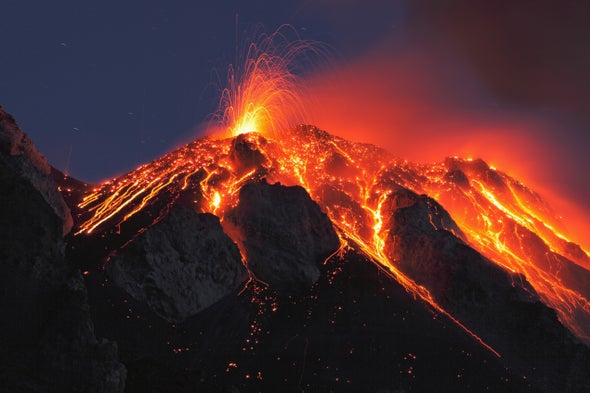
Table of Contents
Q. 9. If subducting plates produce volcanoes, why are there so many volcanic seamounts on the interior of the Pacific Plate?
Response: More than half of the world’s active volcanoes above sea level today encircle the Pacific Ocean to form what is frequently referred to as the circum-Pacific “Ring of Fire.” This horseshoe shaped belt, some 40,000 km long, is associated almost exclusively with nearby ocean trenches, as indicated in the map below produced by the USGS. Almost without exception, the volcanoes are on the side of the trench beneath which the subduction is occurring.
Ring of fire volcanoes
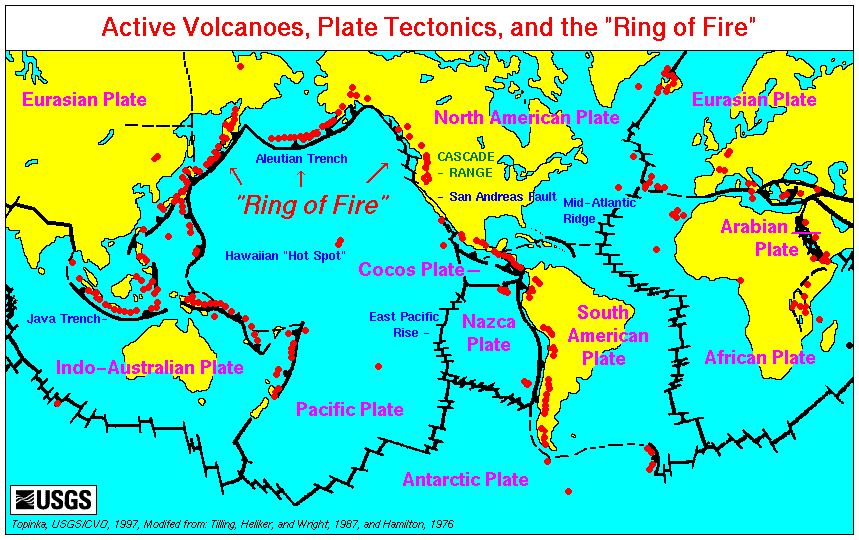
The following discussion of the reason that volcanoes are so commonly associated with subduction is copied from the San Diego State University geology department website:
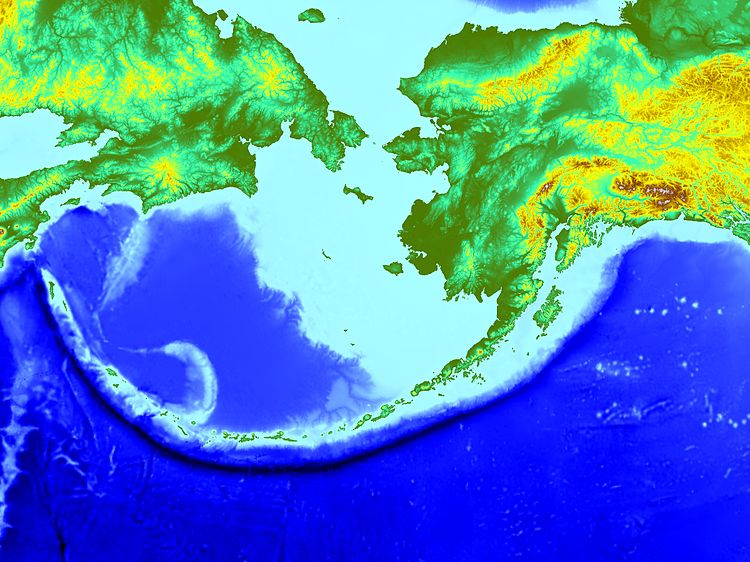
The crustal portion of the subducting slab contains a significant amount of surface water, as well as water contained in hydrated minerals within the seafloor basalt. As the subducting slab descends to greater and greater depths, it progressively encounters greater temperatures and greater pressures which cause the slab to release water into the mantle wedge overlying the descending plate. Water has the effect of lowering the melting temperature of the mantle, thus causing it to melt. The magma produced by this mechanism varies from basalt to andesite in composition. It rises upward to produce a linear belt of volcanoes parallel to the oceanic trench, as exemplified in the above image of the Aleutian Island chain. The chain of volcanoes is called an island arc. If the oceanic lithosphere subducts beneath an adjacent plate of continental lithosphere, then a similar belt of volcanoes will be generated on continental crust. This belt is then called a volcanic arc, examples of which include the Cascade volcanic arc of the U.S. Pacific northwest, and the Andes volcanic arc of South America.
The volcanoes produced by subduction zone volcanism are typically stratovolcanoes. Incipient island arcs tend to be more basaltic in composition, whereas mature continental volcanic arcs tend to be more andesitic in composition.
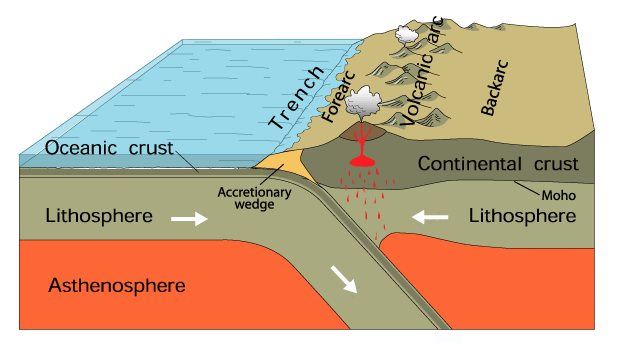
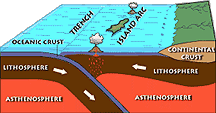
The point here is that the basic mechanism by which subduction so commonly generates volcanism is well understood. One aspect of the process that the above simple article did not include is the so-called ‘corner flow’ that occurs in the asthenospheric wedge between the subducting plate and the overriding plate. This flow, driven by drag from the subducting plate, brings fresh, hot asthenospheric rock, like a blow torch, into the very zone where the volatiles are being released and partial melting takes place.
Other (non ring-of-fire) volcanoes
What about the volcanoes, mostly inactive and below sea level, in the western and central Pacific? These are almost certainly a consequence of the massive hot thermal anomaly in the lower mantle beneath the south central Pacific known as the Pacific superplume. This feature, as well as a similar feature on the opposite side of the earth beneath Africa, together with a ring of anomalously cold and dense rock beneath the perimeter of the Pacific, shown in the figure below, were some of the most visible and robust features in 3D seismic images of the lower mantle from the earliest days of seismic tomography in the 1980s.
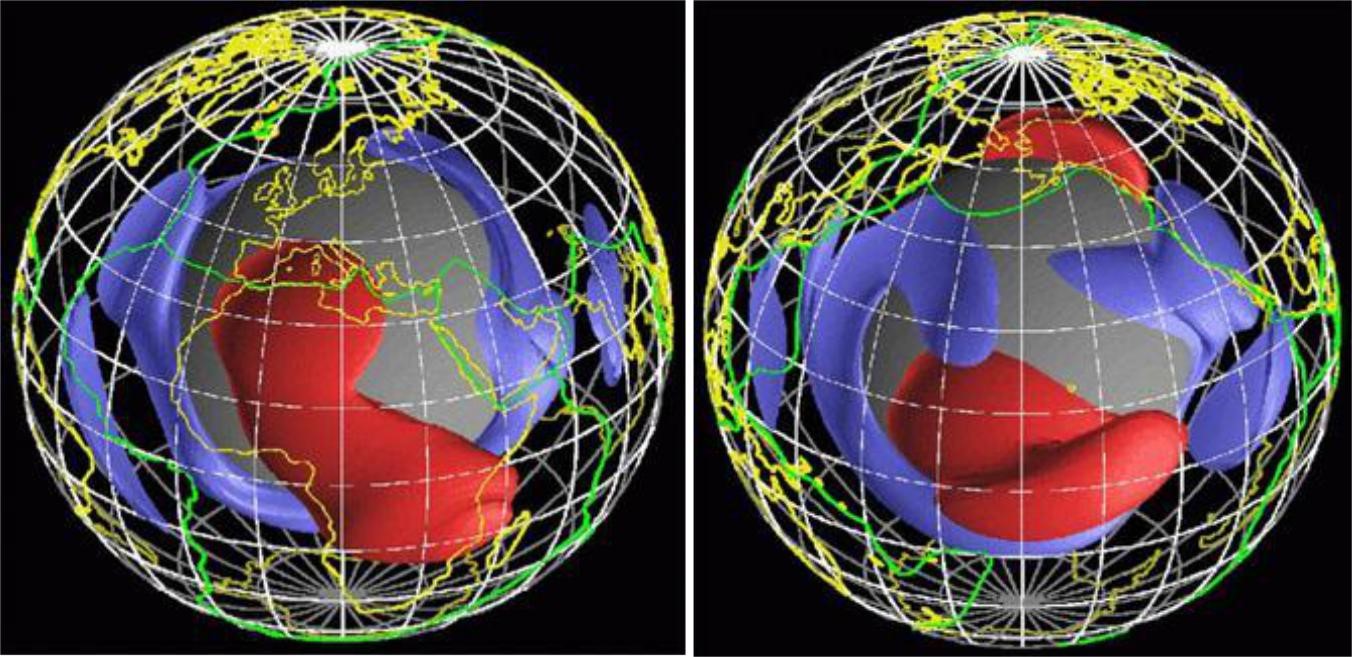
It is noteworthy that observational evidence is compelling that a huge pulse of volcanism occurred in the central Pacific in the mid-Cretaceous. Some of the evidence is described in the paper by R. L. Larson, “Latest pulse of Earth: Evidence for a mid-Cretaceous superplume.”1 The abstract for this paper is as follows:
A calculation of Earth’s ocean crustal budget for the past 150 m.y. reveals a 50% to 75% increase in ocean crust formation rate between 120 and 80 Ma. This “pulse” in ocean crust production is seen both in spreading-rate increases from ocean ridges and in the age distribution of oceanic plateaus. It is primarily a Pacific Ocean phenomenon with an abrupt onset, and peak production rates occurred between 120 and 100 Ma. The pulse decreased in intensity from 100 to 80 Ma, and at 80 Ma rates dropped significantly. There was a continued decrease from 80 to 30 Ma with a secondary peak near the Cretaceous/Tertiary boundary at 65 Ma. For the past 30 m.y., ocean crust has formed at a nearly steady rate. Because the pulse is seen primarily in Pacific oceanic plateau and ridge production, and coincides with the long Cretaceous interval of normal magnetic polarity, I interpret it as a “superplume” that originated at about 125 Ma near the core/mantle boundary, rose by convection through the entire mantle, and erupted beneath the mid-Cretaceous Pacific basin. The present-day South Pacific “superswell” under Tahiti is probably the nearly exhausted remnant of the original upwelling. How this superplume stopped magnetic field reversals for 41 m.y. is a matter of speculation, but it probably involved significant alteration of the temperature structure at the core/mantle boundary and the convective behavior of the outer core.
Seamounts
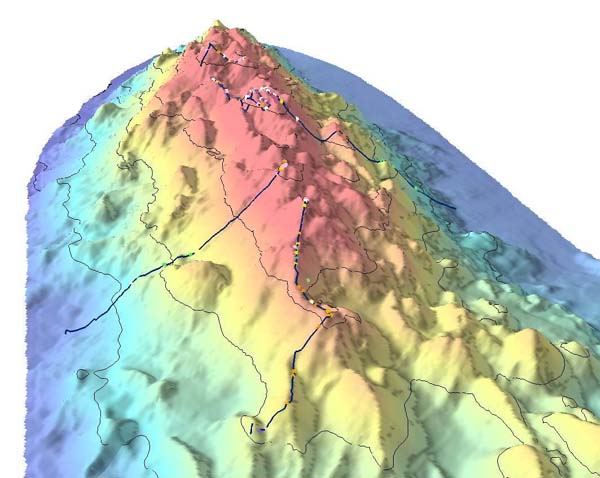
It turns out that most of the seamounts that are so numerous in the western Pacific today were formed precisely in the time window described by Larson. This is documented in the paper by Stepashko, A. A., “Origin of West Pacific seamounts…”2, as summarized in the abstract:
A correlation between the age and position of 25 seamounts in the West Pacific Ocean formed, judging from the 40Ar/39Ar data, in the period from 120 to 65 My B.P. was recognized. The seamounts studied are joined into linear zones with extensions up to 5000 km; the age of the seamounts decreases in the southeastern direction. In the interval 93–83 My B.P., the seamount formation was extremely rapid; this interval coincides with the period of acceleration in the Pacific Plate movements. In the middle of this interval, 87 My B.P., an intensification of the magmatic activity accompanying the seamount formation was observed simultaneously with the extinction of the Isanagi Plate and the appearance of the Kula Plate.
Superswells

What about this south central Pacific region today? A widely referenced paper on this topic is by McNutt and Judge, “The Superswell and Mantle Dynamics Beneath the South Pacific,”3 summarized in its abstract as follows:
The region of sea floor beneath French Polynesia (the “Superswell”) is anomalous in that its depth is too shallow, flexural strength too weak, seismic velocity too slow, and geoid anomaly too negative for its lithospheric age as determined from magnetic isochrons. These features evidently are the effect of excess heat and extremely low viscosity in the upper mantle that maintain a thin lithospheric plate so easily penetrated by volcanism that 30 percent of the heat flux from all hot spots is liberated in this region, which constitutes only 3 percent of the earth’s surface.
Summary
To summarize:
-
Seismic topography shows what appears to be a massive hot thermal anomaly in the lower mantle presently beneath the south central Pacific.
-
A huge pulse of volcanism in this very region during the mid-Cretaceous generated the seamounts that currently populate the Pacific Plate in the western Pacific region.
-
A high level of volcanic activity continues in this region today, but at a level greatly diminished from that of the Cretaceous.
In regard to the claim, the western Pacific seamounts are the result of this thermal anomaly and not to the subduction-related processes which generate the Pacific Ring of Fire volcanoes.
Finally, how do UPT and CPT compare in accounting for these features? First, partial melting and volcanism in subduction zones is to be expected in both versions of plate tectonics. But the huge volumes of subduction-generated silicic volcanism that formed the Sierra Nevada and related granites, for example, are extremely difficult for UPT to explain but readily accounted for within the CPT framework. Uniformitarianism in general has difficulty with non-uniform phenomena like the Cretaceous pulse in central Pacific volcanism, so in terms of accounting for the Pacific seamounts, CPT again displays superior explanatory power.
-
R. L. Larson, “Latest pulse of Earth: Evidence for a mid-Cretaceous superplume,” Geology 19, 547-550, 1991. abstract online ↩︎
-
Stepashko, A. A., “Origin of West Pacific seamounts and features of the Cretaceous dynamics of the Pacific Plate,” Oceanology 46, 411-417, 2006. abstract online ↩︎
-
M. K. McNutt and A. V. Judge, “The Superswell and Mantle Dynamics Beneath the South Pacific,” Science 25, 969 – 975, 1990. abstract online ↩︎